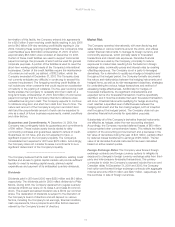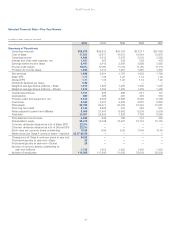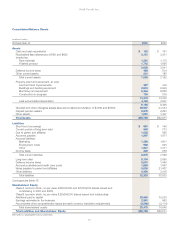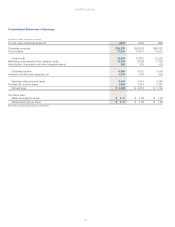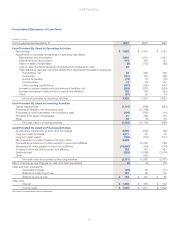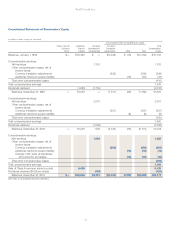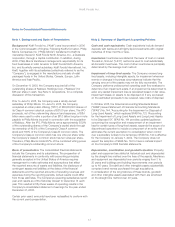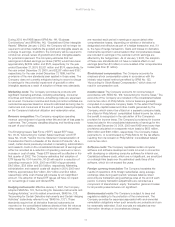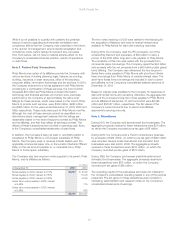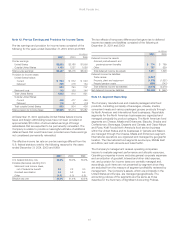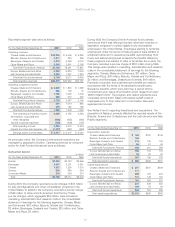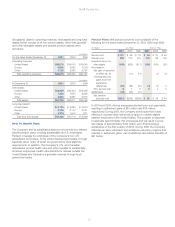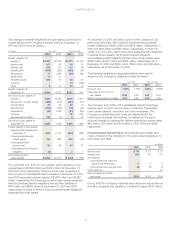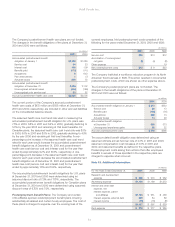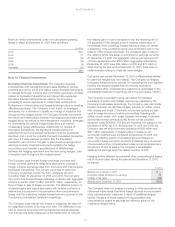Kraft 2001 Annual Report Download - page 50
Download and view the complete annual report
Please find page 50 of the 2001 Kraft annual report below. You can navigate through the pages in the report by either clicking on the pages listed below, or by using the keyword search tool below to find specific information within the annual report.
Kraft Foods Inc.
44
During 2001, the FASB issued SFAS No. 141, “Business
Combinations” and SFAS No. 142, “Goodwill and Other Intangible
Assets.” Effective January 1, 2002, the Company will no longer be
required to amortize indefinite life goodwill and intangible assets as
a charge to earnings. In addition, the Company will be required to
conduct an annual review of goodwill and other intangible assets
for potential impairment. The Company estimates that net
earnings and diluted earnings per share (“EPS”) would have been
approximately $2,839 million and $1.76, respectively, for the year
ended December 31, 2001; $2,531 million and $1.74, respectively, for
the year ended December 31, 2000; and $2,287 million and $1.57,
respectively, for the year ended December 31, 1999, had the
provisions of the new standards been applied in those years. The
Company does not currently anticipate having to record a charge
to earnings for the potential impairment of goodwill or other
intangible assets as a result of adoption of these new standards.
Marketing costs: The Company promotes its products with
significant marketing activities, including advertising, consumer
incentives and trade promotions. Advertising costs are expensed
as incurred. Consumer incentive and trade promotion activities are
recorded as expense based on amounts estimated as being due to
customers and consumers at the end of a period, based principally
on the Company’s historical utilization and redemption rates.
Revenue recognition: The Company recognizes operating
revenue upon shipment of goods when title and risk of loss pass to
customers. The Company classifies shipping and handling costs
as part of cost of sales.
The Emerging Issues Task Force (“EITF”) issued EITF Issue
No. 00-14, “Accounting for Certain Sales Incentives” and EITF
Issue No. 00-25, “Vendor Income Statement Characterization of
Consideration Paid to a Reseller of the Vendor’s Products.” As a
result, certain items previously included in marketing, administration
and research costs on the consolidated statement of earnings will
either be recorded as a reduction of operating revenues or as an
increase in cost of sales. These EITF Issues will be effective in the
first quarter of 2002. The Company estimates that adoption of
EITF Issues No. 00-14 and No. 00-25 will result in a reduction of
operating revenues in 2001, 2000 and 1999 of approximately
$4.6 billion, $3.6 billion and $3.4 billion, respectively. Marketing,
administration and research costs will decline in 2001, 2000 and
1999 by approximately $4.7 billion, $3.7 billion and $3.4 billion,
respectively, while cost of sales will increase by an insignificant
amount. The adoption of these EITF Issues will have no impact
on net earnings or basic and diluted EPS.
Hedging instruments: Effective January 1, 2001, the Company
adopted SFAS No. 133, “Accounting for Derivative Instruments and
Hedging Activities,” and its related amendment, SFAS No. 138,
“Accounting for Certain Derivative Instruments and Certain Hedging
Activities” (collectively referred to as “SFAS No. 133”). These
standards require that all derivative financial instruments be
recorded on the consolidated balance sheets at their fair value as
either assets or liabilities. Changes in the fair value of derivatives
are recorded each period in earnings or accumulated other
comprehensive losses, depending on whether a derivative is
designated and effective as part of a hedge transaction and, if it
is, the type of hedge transaction. Gains and losses on derivative
instruments reported in accumulated other comprehensive losses
are included in earnings in the periods in which earnings are
affected by the hedged item. As of January 1, 2001, the adoption
of these new standards did not have a material effect on net
earnings (less than $1 million) or accumulated other comprehensive
losses (less than $1 million).
Stock-based compensation: The Company accounts for
employee stock compensation plans in accordance with the
intrinsic value-based method permitted by SFAS No. 123,
“Accounting for Stock-Based Compensation,” which does not
result in compensation cost.
Income taxes: The Company accounts for income taxes in
accordance with SFAS No. 109, “Accounting for Income Taxes.” The
accounts of the Company are included in the consolidated federal
income tax return of Philip Morris. Income taxes are generally
computed on a separate company basis. To the extent that foreign
tax credits, capital losses and other credits generated by the
Company, which cannot be utilized on a separate company basis,
are utilized in Philip Morris’ consolidated federal income tax return,
the benefit is recognized in the calculation of the Company’s
provision for income taxes. The Company’s provisions for income
taxes included in the consolidated statements of earnings for the
years ended December 31, 2001, 2000 and 1999 were lower than
provisions calculated on a separate return basis by $185 million,
$139 million and $107 million, respectively. The Company makes
payments to, or is reimbursed by, Philip Morris for the tax effects
resulting from its inclusion in Philip Morris’ consolidated federal
income tax return.
Software costs: The Company capitalizes certain computer
software and software development costs incurred in connection
with developing or obtaining computer software for internal use.
Capitalized software costs, which are not significant, are amortized
on a straight-line basis over the estimated useful lives of the
software, which do not exceed five years.
Foreign currency translation: The Company translates the
results of operations of its foreign subsidiaries using average
exchange rates during each period, whereas balance sheet
accounts are translated using exchange rates at the end of each
period. Currency translation adjustments are recorded as a
component of shareholders’ equity. Transaction gains and losses
for all periods presented were not significant.
Environmental costs: The Company is subject to laws and
regulations relating to the protection of the environment. The
Company provides for expenses associated with environmental
remediation obligations when such amounts are probable and can
be reasonably estimated. Such accruals are adjusted as new
information develops or circumstances change.


